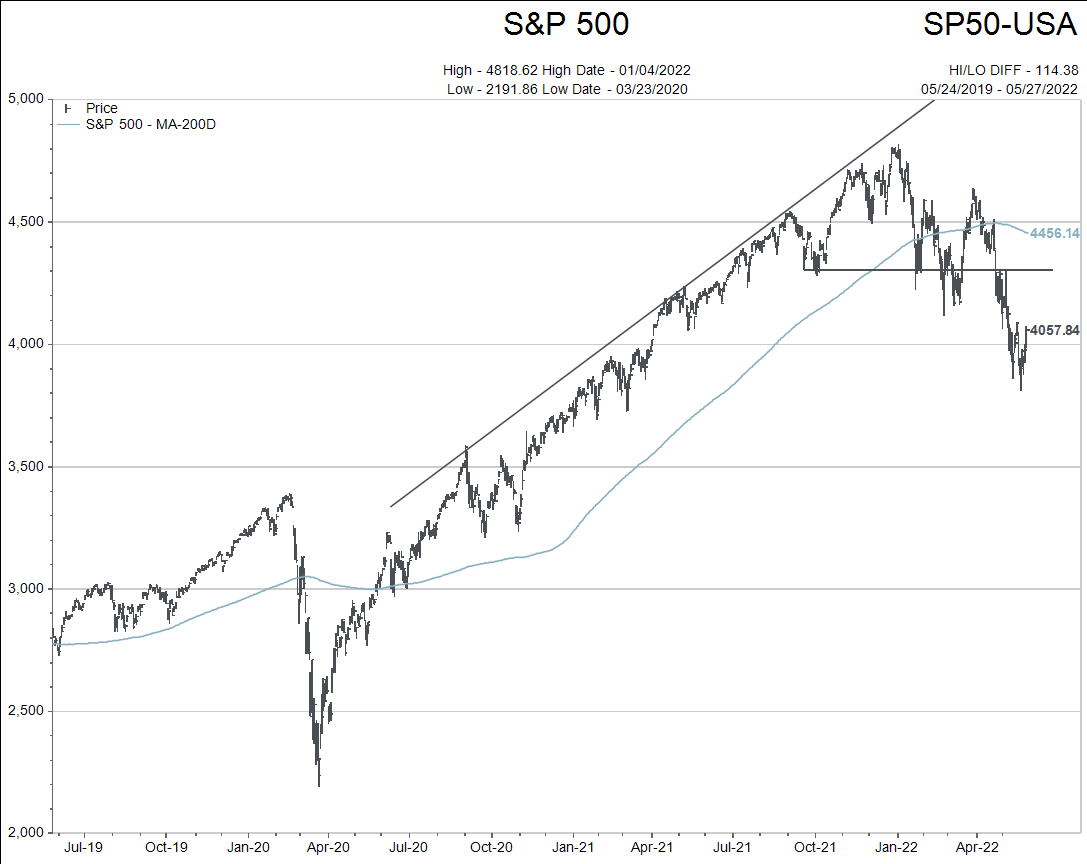Buying the Mythical Bottom
Every investor would love to ride the BULL market higher, sell all their holdings at the top, and know exactly when to buy the exact day the market bottoms.
That doesn’t happen…except on Twitter.
What does happen by using a quality process, an investor can scale out of their some of their holdings as the stock market tops and scales back in somewhere near the bottom.
It is now time to begin to start looking for a bottom.
There are two strategies I have used to add exposure back into portfolios in the past. Neither is perfect and I have one that I prefer to use. The next few paragraphs will outline both:
“Adding During the Decline” (Not my preferred method)
The idea here is to begin buying at either PRICE or TIME intervals. Let’s use the present US stock market decline as an example.
On Friday, May 20th the S&P 500 had declined more than 20% in the 2022 calendar year. Many define the 20% decline level as a statistical BEAR market and, therefore, begin to deploy cash as history shows that over the next 12 months the stock market tends to be at higher levels. This is an example of using PRICE levels to buy into a BEAR market.
The difficulty with using this method is nobody knows how far a BEAR market is going to extend to the downside. Referring to my favourite chart of the S&P500 one can see there are no technical patterns indicating the decline is finished.

Therefore, the price level of a 20% decline does provide an “averaging in” opportunity for investor using the “Adding During the Decline” method of BEAR market investing but does nothing to protect against a larger scale decline. Hence it is not my preferred method.
Adding to a Measurable Bottom (Preferred)
Adding to a measurable bottom uses both fundamental and technical data. Here are the main advantages to using this method of adding to stock exposure during a BEAR market.
- A “stop-loss” for added funds is easy to create using the “old trading bottom” on the chart as an exit point.
- Fundamental (economic) data is considered rather than pure technical and stochastic data.
- Risk range data must be neutral rather than negatively skewed.
- Retail investor sentiment will be negatively positioned.
The macro outlook for the economic data is what gives me the most compelling pause. Here is what concerns me about rallies in risk assets here:
The central banks want to raise interest rates to get nearer a “neutral” interest rate environment. The longer risk assets, along with oil and real estate stay higher in price, the further the central banks can afford to push interest rates higher. This buys them precious room to lower rates in the next recession.
It is really that simple.
The “Adding to a Measurable Bottom” system for buying back equity investments to portfolios is highly sensitive to the emboldened statement above and its inflection point where additions can be made to portfolios with a greater safety net.
Central Bank Interest Rate Increases
Here are the dates when the US Federal Reserve is going to meet:
June 15th, July 27th and then September 22nd.
The Fed has locked and loaded interest rate increases of 0.50% for the June and July meetings. There are two months of time for the US Fed to look and see how things play out in the economy until the September meeting.
My bet today is there will be NO interest rate increase on September 22nd for the US Fed because the fundamental data will show the US economy is in a mild recession.
Now we look at the Bank of Canada meeting dates. These are far more interesting than the US dates.
June 1st, July 13th and September 7th.
Wow, those are going to come fast and furious!
So here is the deal for Canada. The June 1st meeting will be a 0.50% increase. But from that meeting forward, Canada is not easy to estimate.
Canada has a much larger real estate bubble than the US. Canada also has an economy that is about twice as exposed in GDP terms to real estate and the real estate related industries.
The risk management for the Bank of Canada is significantly more challenging than the US Fed.
I have no strong feelings about how the Bank of Canada will handle these three meetings outside of the June 1st meeting. (A 0.50% increase).
My goal is to watch the data and the markets to decide what direction to head in terms of investing.
